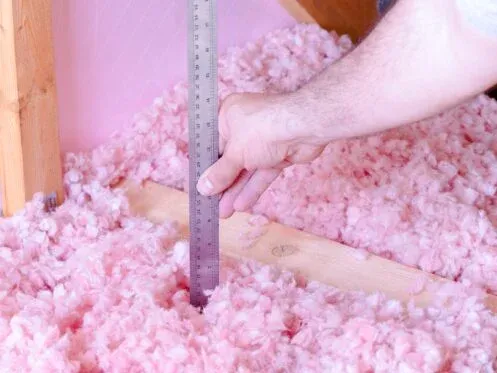Insulation is essential for maintaining a comfortable Sacramento, CA home. It can also keep energy costs down by enhancing the efficiency of your HVAC system. Different kinds of insulation are available. There are also factors to consider, including whether you have an attic or basement, the type of insulation you currently have, and your finances. Working with Atticman Heating and Air Conditioning, Insulation can help you make the best insulation choice for your home.
Understanding R-Value
Before exploring your insulation options, it’s helpful to understand what R-value means. R-value measures how well a material resists the transfer of heat. The higher the R-value, the better the material insulates against temperature changes, helping keep warm air inside during the winter and outside during the summer.
R-value is influenced by both the type of material and its thickness. For example, dense materials like closed-cell spray foam generally offer higher R-values per inch than fiberglass batts or blown-in cellulose.
In many homes, combining different types of insulation is a practical way to improve overall energy performance. However, some materials work better together than others. For instance, rigid foam board can be installed against the wall and then covered with fiberglass batts to increase the total R-value without compromising airflow or causing moisture issues.
Hiring a professional to install new insulation is essential, because even the highest-quality insulation can’t deliver optimal performance if installed incorrectly. Gaps, compression, or missing vapor barriers can significantly reduce R-value and lead to issues like drafts, moisture accumulation, or mold growth. Our professional will ensure that materials are installed according to code, paired correctly, and appropriately sealed to deliver the energy savings and comfort you expect.
Fiberglass Insulation
Fiberglass insulation is very popular thanks to its affordability. It’s also fire-resistant and can be used in a variety of areas, such as attics, crawl spaces, flooring, ceilings, and walls. Made from glass fibers, this type of insulation is available as loose-fill, rolls, or batting.
Fiberglass insulation can become less effective when it is exposed to water. It is generally resistant to mold, although mold can grow on it in the right conditions. It has an R-value of R-11 to R-60, depending on how thick it is and its density.
Spray Foam Insulation
Spray foam is a more expensive insulation option, but it’s ideal for tight spaces and areas that are hard to reach. It is applied as a liquid and hardens to form a tight barrier. You can choose between closed-cell and open-cell spray foam. This product has a very high R-value, usually between R-3.6 and R-4 per inch for open-cell products and R-6 and R-7 per inch for closed-cell products.
This type of insulation can resist water and is resistant to mold. It can last for 30 years or more when installed correctly by a professional. These qualities make it ideal for attics, basements, and small gaps around roof protrusions or anywhere else where moisture or mold could be a concern.
Cellulose Insulation
If you’re looking for an environmentally friendly insulation option, cellulose materials are ideal. They are made from recycled paper that is treated with fire-retardant chemicals. They do a good job of reducing airflow thanks to an R-value of R-3.2 to R-3.8 per inch. It’s ideal for walls and attics. Cellulose insulation tends to be very affordable, making it a good choice for large areas. However, it has the downside of being able to absorb water. It can also compress over time, reducing its effectiveness.
Foam Board Insulation
Foam board insulation can be made from various materials, including polyisocyanurate, polyurethane, or polystyrene. It provides an impressive R-value of up to 6.5 per inch. It’s ideal for larger areas since it can be cut to fit spaces like walls and ceilings. It’s very resistant to moisture, so it’s great for damp areas like basements. It can even add to the structural integrity of exterior walls. It’s an excellent option if you’re finishing your basement or attic.
Radiant Barrier Insulation
Radiant barrier insulation uses reflective materials like aluminum foil to reduce heat gain by reflecting radiant heat rather than absorbing it. This makes it especially effective in attics, where direct sunlight can cause temperatures to soar during the spring and summer. When installed beneath the roof decking or along the attic rafters, it helps prevent heat from entering the living space below. Radiant barriers are best suited for hot, sunny areas and not recommended for cooler areas like basements, where heat loss rather than heat gain is the primary concern.
Rockwool Insulation
Rockwool insulation, also known as mineral wool, is made by melting natural rock and recycled slag at extremely high temperatures. Manufacturers then spin the molten material into fibers, much like how cotton candy is made. This process creates a dense, durable insulation material with excellent thermal and acoustic properties. Rockwool typically has an R-value between R-3.0 and R-4.3 per inch.
In addition to helping regulate indoor temperatures, rockwool is naturally resistant to fire and moisture, making it a reliable option in areas with high heat or humidity. It also provides soundproofing benefits, which can contribute to a quieter, more peaceful home. Because of its ability to withstand high temperatures, it’s particularly effective in attics or around heating and cooling systems. However, it tends to be more expensive than other types of insulation and can be challenging to install without proper tools or experience.
The Benefits of Insulation Upgrades
By creating a tighter home envelope, you’ll be able to maintain a comfortable indoor temperature without having to overuse your HVAC system. This can protect your heating and cooling equipment, leading to fewer repairs and a longer system lifespan. You should also see a decrease in your monthly energy bills.
Insulation upgrades can also boost the value of your home. If you’re going to put your home on the market soon, this is a major selling point. Not only will the buyer not have to worry about investing in insulation, but they’re moving into a home that they know was well taken care of.
Depending on the type of insulation you choose, you may achieve better fire resistance for your residence. This extra added layer of safety will keep you and your family safe and protect your investment.
Another benefit of tightening your home’s envelope is that it will keep out airborne contaminants. This improved indoor air quality can be critical if you or a family member has respiratory conditions like allergies or asthma.
Additionally, keep in mind that there may be tax incentives and rebates available when you upgrade your insulation. This can offset costs, making it possible to reap the benefits of long-term savings with a lower initial investment.
Contact Your Local Pros
At Atticman Heating and Air Conditioning, Insulation, we have been serving the residents of Sacramento, CA and the surrounding areas for years. We can help you determine if your home will benefit from an insulation upgrade. If you decide to go forward with the project, we will help you choose the right materials and ensure they are correctly installed. Contact us today to schedule an appointment with one of our experienced technicians.


